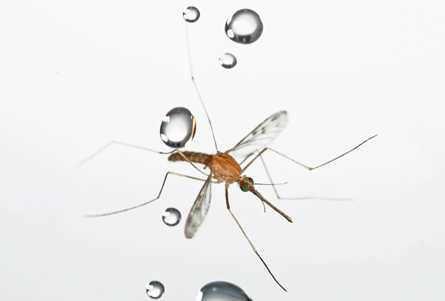We're open daily this holiday! View holiday hours
Science News
Mosquitoes in the Rain
June 5, 2012

When it comes to how insects and water interact, look no farther than researchers at Georgia Tech.
Last year we featured remarkable rafting ants—fire ants that band together to float, instead of sink, in a pool of water. And scientists from the same lab, publishing in the Proceedings of the National Academy of Sciences yesterday, report how mosquitoes are able to survive raindrops 50 times heavier than the small insects.
What would that be like? NPR gives one example:
Imagine how tough life would be if raindrops weighed 3 tons apiece as they fell out of the sky at 20 mph.
ScienceNOW provides another:
The drop should have the impact of a bus running over a human and drive the mosquito downward at a force up to 300 times that of gravity.
But the researchers in David Hu’s lab found that for lightweight mosquitoes, flying through the rain is like a walk in the park. The insects receive low impact forces from raindrops because the low mass of mosquitoes causes raindrops to lose little momentum upon impact.
Pelting the mosquitoes with raindrops in the lab, the researchers found that often the drops hit the insects’ legs, rolling right off and inconveniencing the bugs very little. If the drop did engulf a mosquito, it was carried down for a bit, but the mosquito was able to separate itself from the water before hitting the ground.
The team filmed the free-flying mosquitoes and found that upon impact a mosquito would adhere to the front of the drop for up to 20 body lengths.
“To survive, the mosquito must eventually separate from the front of the drop,” Hu says. “The mosquito accomplishes this by using its long legs and wings, whose drag forces act to rotate the mosquito off the point of contact. This is necessary, otherwise the mosquito will be thrown into the ground at the speed of a falling raindrop.”
“The collision force must equal the resistance applied by the insect,” Hu explains. “Mosquitoes don't resist at all but simply go with the flow.”
What the researchers learned about mosquito flight could be used to enhance the design features of tiny, flying robots—micro-airborne vehicles (MAVs), which are increasingly being used by law enforcement and the military in surveillance and search-and-rescue operations.
You can view a video of mosquitoes in the rain here.
Image: Tim Nowack, Andrew Dickerson and David Hu/Georgia Tech